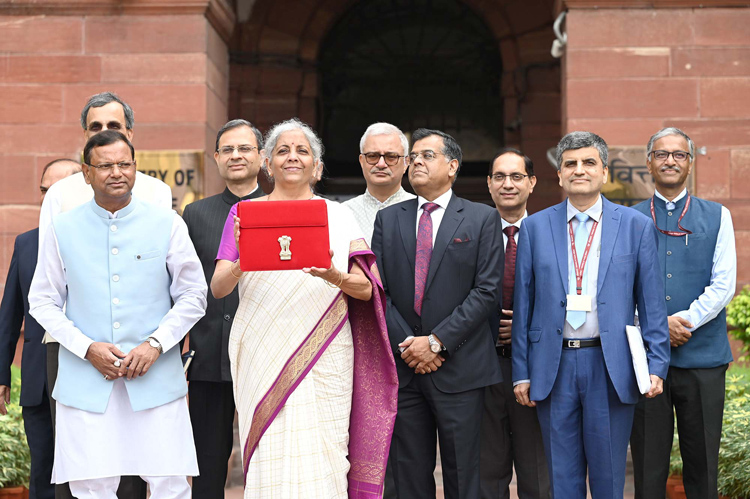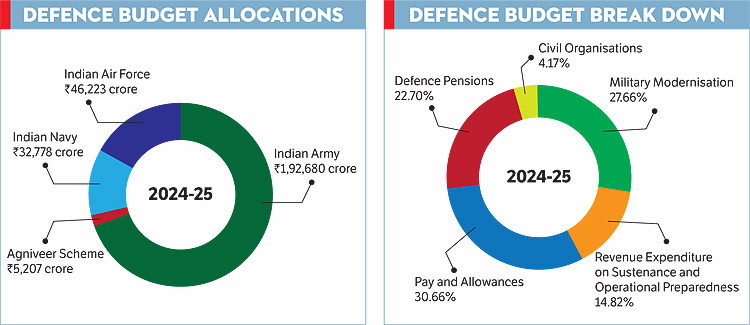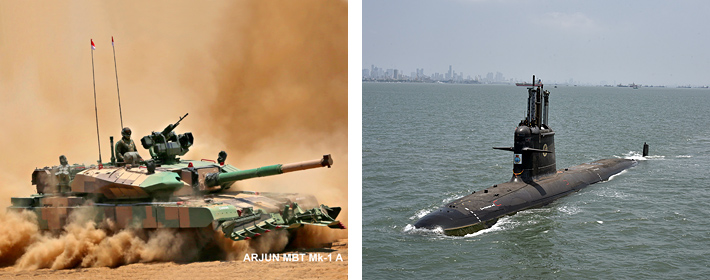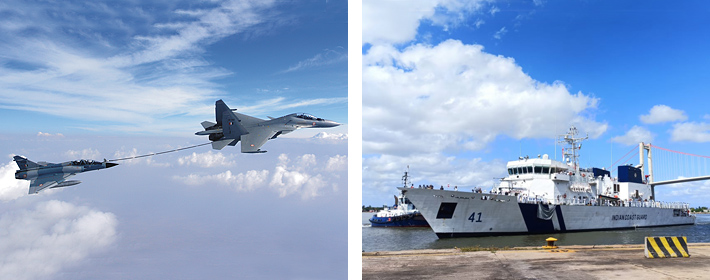INDIAN ARMED FORCES CHIEFS ON
OUR RELENTLESS AND FOCUSED PUBLISHING EFFORTS

SP Guide Publications puts forth a well compiled articulation of issues, pursuits and accomplishments of the Indian Army, over the years

I am confident that SP Guide Publications would continue to inform, inspire and influence.

My compliments to SP Guide Publications for informative and credible reportage on contemporary aerospace issues over the past six decades.
Defence Budget 2024-25 remains static, puts thrust on military R&D with higher allocation
While the defence budget follows the interim budget, the Government has made an additional allocation of ₹400 crore for innovation in military technologies, a higher allocation to the Agniveer scheme and a massive thrust towards building border infrastructure. However, industry demands a higher capital allocation to achieve indigenous acquisition of 3 lakh crore by 2029.

In the Union Budget for Financial Year (FY) 2024-25, the Ministry of Defence (MoD) has allocated ₹6.22 lakh crore (approximately $75 billion) to boost India's defence capabilities and self-reliance.
While the defence budget follows the interim budget, the Government has made an additional allocation of ₹400 crore for innovation in military technologies, under the Innovations for Defence Excellence (iDEX) initiatives. The budget for iDEX has been increased from ₹115 crore during FY 2023-24 to ₹518 crore in the current fiscal year.
In the budget, the Army has received ₹1,92,680 crore for 2024-25 with additional focus and funding for the Agniveer scheme, raising it to ₹5,207 crore in the budget for 2024-25. The Navy and the Indian Air Force have been allocated ₹32,778 crore and ₹46,223 crore respectively.
In the Union Budget for FY 2024-25, the Ministry of Defence (MoD) allocated ₹6.22 lakh crore (approximately $75 billion) to enhance India's defence capabilities and self-reliance, marking it as the highest allocation among all ministries.
Out of the total defence budget, a share of 27.66 per cent goes to capital (military modernisation); 14.82 per cent to revenue expenditure on sustenance and operational preparedness; 30.66 per cent to Pay and Allowances; 22.70 per cent to Defence Pensions, and 4.17 per cent to civil organisations under the MoD.
According to the government, the total allocation comes out as approx. 12.90 per cent of Budgetary Estimate of Union of India. This allocation marks a 4.79 per cent increase from the previous fiscal year, making it the highest among all ministries.
However, given India's accelerated economic growth, the overall Defence budget in year-on-year terms is reducing as a percentage of GDP.
Jayant Patil, Member of Executive Committee of Management Larsen & Toubro, looks at the defence capital budget, points out: "The Defence Capital Budget has more or less remained unchanged at 172 thousand crores over the Vote on Account budget except for a minor increase of 400 crore."

The iDEX scheme is geared towards supporting and building indigenous capabilities with start-ups/MSMEs and innovators to develop Def-Tech solutions and supply the Indian military. A grant of up to 50 per cent of Product Development Budget with an enhanced limit (Max) of ₹25 crore per applicant will be awarded as per extant iDEX guidelines.
A significant feature of the budget is the increased funding for the Agniveer scheme. The army, which was allocated ₹23 crore in 2022-23, has been given a hike to ₹2,836 crore in the interim budget and another hike to ₹5,207 crore in the budget for 2024-25.
The budget for the Innovations for Defence Excellence (iDEX) initiative saw a substantial increase from ₹115 crore in FY 2023-24 to ₹518 crore in FY 2024-25, aimed at fostering indigenous defence technology development.
Defence Minister Rajnath Singh called the defence budget a substantial budget and said, "As far as the allocation to the Ministry of Defence is concerned, I thank the Finance Minister for giving the highest allocation to the tune of ₹6,21,940.85 crore, which is 12.9 per cent of the total Budget of the Government of India for FY 2024-25."
Defence Budget for Research & Development (DRDO)
The budgetary allocation to the Defence Research and Development Organisation (DRDO) has been increased to ₹23,855 crore in FY 2024-25 from ₹23,263.89 crore in FY 2023-24. In the total budget for the DRDO, a significant allocation of ₹13,208 crore is marked for capital expenditure.
The objective is to continue leveraging and strengthening DRDO, which is the sole R&D agency involved in developing a wide spectrum of technologies and systems for the Indian Armed Forces.
The renewed thrust on DRDO is evident with a wider mandate on fundamental and core areas of research in defence and aerospace. The budgetary allocation also mandates DRDO to develop new military systems/equipment with the domestic private defence entities through Development-cum-Production Partners. The making of Light Tank Zorwar is such a collaboration which boosts indigenisation.
The allocation to the Defence Research and Development Organisation (DRDO) increased to ₹23,855 crore in FY 2024-25, with a significant portion dedicated to capital expenditure for new military systems and technology innovation.
Another key initiative of the government under the DRDO, the Technology Development Fund (TDF) scheme stands out to be ₹60 crore annually which is specially designed for new start-ups, MSMEs and academia attracting young bright minds interested in innovation. The TDF is instrumental in developing niche technology in collaboration with DRDO. It is important to note that TDF promotes innovation in emerging and advanced technologies, partnering with the industry, and has a substantial mandate to drive such innovation with budget reaching over ₹500 crore in total. The budgetary allocation of ₹60 crore indicates the annual markup for the planned projects. The scheme aims to encourage and establish a comprehensive ecosystem of military capabilities in cutting-edge technology and fostering Atmanirbharta (self-reliance) in the defence sector.
Budget for military modernisation
In absolute terms, budgetary allocation under the capital head to the Defence Forces for FY 2024-25 is ₹1.72 lakh crore, which is 20.33 per cent higher than the actual expenditure of FY 2022-23. The capital allocation is 9.4 per cent more than the Revised Allocation for FY 2023-24.
This is in line with keeping the pace of modernisation for the potential big-ticket acquisitions which involve large military platforms and advanced systems. The required capital is planned for the gradual acquisition of fighter aircraft, warships, submarines, unmanned aerial vehicles, drones, and other specialist vehicles etc.
The government has continued to put a thrust on domestic industries to procure new systems and platforms. MoD has earmarked a significant percentage of the modernisation budget amounting to ₹1,05,518.43 crore for procurement through domestic industries. While many big-ticket domestic purchases are on the card, the allocation remains unchanged.


(Above Left) Su-30 MKI REFUELLING MIRAGE; (Above Right) Indian Coast Guard Offshore Patrol Vessel ICGS Varaha
On prioritising the domestic industry, Jayant Patil outlines that while this is good as there are no surprises, the capital allocation increases over the past year (172 thousand crore against 162 thousand crore) as well as an allocation for indigenous acquisition (105 thousand crore for FY25 over 100 thousand crore for FY24) have shown a further increase.
"However, these could be higher keeping an eye on the long-term target of reaching Indigenous production of 3 lakh crore by 2029," Patil further explained the need for higher capital allocation to achieve indigenous acquisition.
The budget for military modernisation under the capital head was ₹1.72 lakh crore, a 20.33 per cent increase over FY 2022-23, focusing on acquiring advanced military platforms and systems.
The government maintained the Capital allocations with the army getting ₹33,411 crore, the navy getting ₹51,052 crore and the air force getting the largest hike of ₹58,112 crore.
However, the capital budget will be adjusted to the gradual cash outflows against the purchases. Thus, it will leave a narrow window for further acquisitions.
"We are sure in real terms the spending will go up during the year as Government always provides for what is needed for the Defence of the country," Patil puts up with expectation.
The budget for operational readiness has seen the continued higher allocation, allocating ₹92,088 crore during the current FY under this head, which is 48 per cent higher than the budgetary allocation of FY 2022-23. The allocation is important for the maintenance and upkeep of the existing systems and platforms, including aircraft and warships for the services.
The sustenance budget also includes the procurement of ammunition and the mobility of resources & personnel. Notably, it also includes military deployment in forward areas as needed.
Higher budget for the Border Roads Organisations
The key highlight of the defence budget is the significant increase in the allocation for developing border infrastructure. The lead agency under the MoD, Border Roads Organisations (BRO) is involved in executing strategically-significant projects along the border areas, especially along the difficult mountainous terrains, bordering China. With the capital infusion of ₹6,500 crore, the BRO gets a sizeable increase of 30 per cent from the FY 2023-24.
The budget included a 30 per cent increase in allocation for the Border Roads Organisation (BRO), amounting to ₹6,500 crore, to fund strategically significant infrastructure projects along India's borders.
According to the MoD officials, several key Projects of strategic importance such as the Nyoma Airfield in Ladakh at an altitude of 13,700 feet, permanent bridge connectivity to southernmost Panchayat of India in Andaman and Nicobar Islands, 4.1 km strategically-important Shinku La tunnel in Himachal Pradesh, Nechiphu tunnel in Arunachal Pradesh and many other projects will be funded out of this allocation.
Budget for the Indian Coast Guard
The allocation to the Indian Coast Guard (ICG) for this FY 2024-25 is ₹7,651.80 crore, which is 6.31 per cent higher than the allocation for FY 2023-24. Out of this, ₹3,500 crore is to be incurred only on capital expenditure, adding teeth to the arsenal of ICG for addressing the emerging maritime challenges and providing humanitarian assistance to other nations. The allocation will facilitate the acquisition of fast-moving patrolling vehicles/interceptors, advanced electronic surveillance systems and weapons.
Defence Pension Budget and ECHS
Total budgetary allocation on account of defence pensions is ₹1,41,205 crore which is 2.17 per cent higher than the allocation made during 2023-24. It will be incurred on monthly pension to approximately 32 lakh pensioners through the System for Pension Administration (Raksha) or SPARSH and through other pension disbursing authorities.
Additionally, covering better healthcare facilities for veterans, in the regular budget for FY 2024-25, ₹6,968 crore has been allotted under the Ex-Servicemen Contributory Health Scheme (ECHS) to the veterans and their dependents.
Manish Kumar Jha is a Consulting & Contributing Defence Editor for SP's Aviation, SP's Land Forces and SP's Naval Forces and a security expert. He writes on national security, military technology, strategic affairs & policies.





